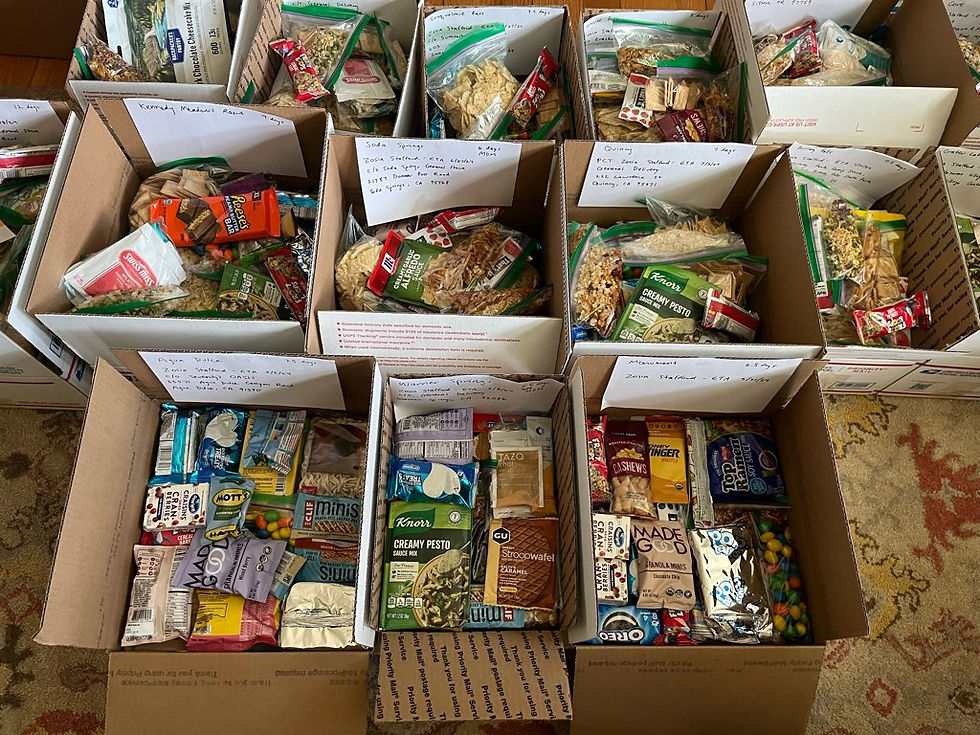Logistics
- Zosia Stafford
- Jul 9, 2022
- 5 min read
Updated: Mar 4, 2024
There are many factors to think of when deciding starting and ending times for the PCT. On average, the PCT takes about five months to hike. The major considerations are temperatures in the desert, snowfall/snowmelt in the Sierras, and winter in Washington. There's a short window where all the timing lines up correctly. For NOBO hikers, this means leaving between late March and mid May, depending on how fast you walk and preferences on hiking company.

Start Date
The official start date of the PCT is April 24(ish). If you're a new hiker and want a whole lot of company when hiking, then this is a great time to begin the hike. You'll be part of what's called the "Bubble" - a bunch of hikers starting all together. Personally, that's not something I'm super interested. I'm pretty confident in my backpacking abilities, and want to have a little more space on the trail. That means I need to leave a couple weeks before or after this date. If I push into May, I need to be sure I can have a fast hiking pace in order to make it to the Sierras in time - the casual cut-off date for that is June 15th, though of course it changes year to year. This is because waiting too long means the snow is melting too fast - the river crossings will be significantly more dangerous, and hiking mountain passes in slush is not great. I'll also have to rush to avoid running into winter in the Cascades of Washington. Ending later in October runs a serious risk of catching a full winter climate, which is undesirable. Starting late also means the desert will be a little hotter, and hiking faster means that there's a good chance I'll catch up to the Bubble too, which doesn't interest me much. On the other hand, if I start late March, then I'll be fairly alone on the trail. The desert will be much cooler, and pretty free of bugs. And starting early means that running into bad forest fires is less likely, though of course never a guarantee. But getting to the Sierras early on a high snow year means I'll just be waiting around for the passes to open up, or try to go into the Sierras in potentially dangerous conditions when the mountains are fully snowed over. Therefore, my happy medium is to start early April. Starting between April 1-10 means I'll miss the crowds, avoid a scorching hot desert, and hopefully reach the Sierras at the golden time where the snowfall and snowmelt are both minimal.
On a more personal note, once I decided the start date, I needed to choose when in my life I'd begin the hike. Then, I was just starting my senior year of college, where I was studying mechanical engineering at Tufts. I considered doing the hike immediately after graduation, but school ended mid-May, which would make starting very difficult. If I got a full-time job after undergrad, I could maybe work a year or two and then see if I could get time off or change jobs. But I was also considering going to graduate school, and ultimately that seemed the best plan - both for academic and professional reasons, but also for hike planning. I would do my Master's in materials science in three semesters, ending in December 2023, and then have a little over three months to finish preparations before starting in April 2024.
General Schedule
The PCT is divided into five main sections: the desert, the Sierras, Northern California, Oregon, and Washington. Three of these are in California - CA is loooonnggg. You reach the halfway point of the PCT before crossing the border, which can be quite demoralizing. A couple notes I've heard on how to tackle each of these sections are below.
Desert: when the weather is too hot, take siestas during the day and night hike from 4am to 10am and then 4pm to 10pm. This will take you out of the sun for the worst of it. Carry a liter more than you think you need and never rely on water caches. The desert is not flat, be prepared for mountains as you pass through the Sonoran and Mojave deserts.
The Sierras: be prepared for massive elevations - you'll be doing about a pass a day. Kennedy Meadows marks the beginning of the ascent, and you'll need a bear box starting then. Be careful with snow - use an ice axe if needed. There will be lots of river crossings, be sure to cross with people near you, either one at a time or holding hands with everyone.
Northern California: often described as a bit of a disappointment after the Sierras, but still pretty. A number of burnt forests, and a bit more desert in Seiad Valley.
Oregon: not very eventful, a lot of similar looking forests. A lot of sandy trails and volcanic ash - very rough on shoes and socks.
Washington: be prepared for rain and snow, get a new raincoat. Cascades have some of the steepest sections, and there's fewer well-supplied towns. No lack of river and lakes, but don't be complacent - still filter water.
Permits
The PCT requires 3 permits:
PCT long distance permit (hardest to get)
California fire permit
Canada entry permit
The California fire permit is given to anyone who applies - it doesn't allow campfires, but lets you use a camp stove unless otherwise posted. Likewise, the Canada entry permit is fairly easy to get as a US citizen. You can leave the US on the trail, but without the entry permit, you can't leave the trail into Canada, and can receive a massive fine if you enter Manning Park without one.
The PCT long distance permit is the hardest to obtain. It acts as a permit for the entire trail, and includes any individual permits you'd need to enter each park you pass through. It also allows hikers to climb Mt Whitney from the PCT trail side without needing a separate trail. These permits are getting more and more competitive to get, so you want to have a couple start dates you're happy with. These permits are available Nov 9 and Jan 11 at 10:30 (at least they were in 2022) - about 1/4 of the permits are reserved for the January release, so don't worry too much if you don't get what you want. Also, there's a large turnover of permits, so keep a lookout for any dropped dates. The permits go by lottery - everyone with an account is assigned a time between 10am and 3pm the night before. When it's your time, go onto the site and choose which date looks good (or whichever dates are left). When you get in, be ready to give your start date, start location, end location, name, address, email, phone number, date of birth and method of travel.




Comments